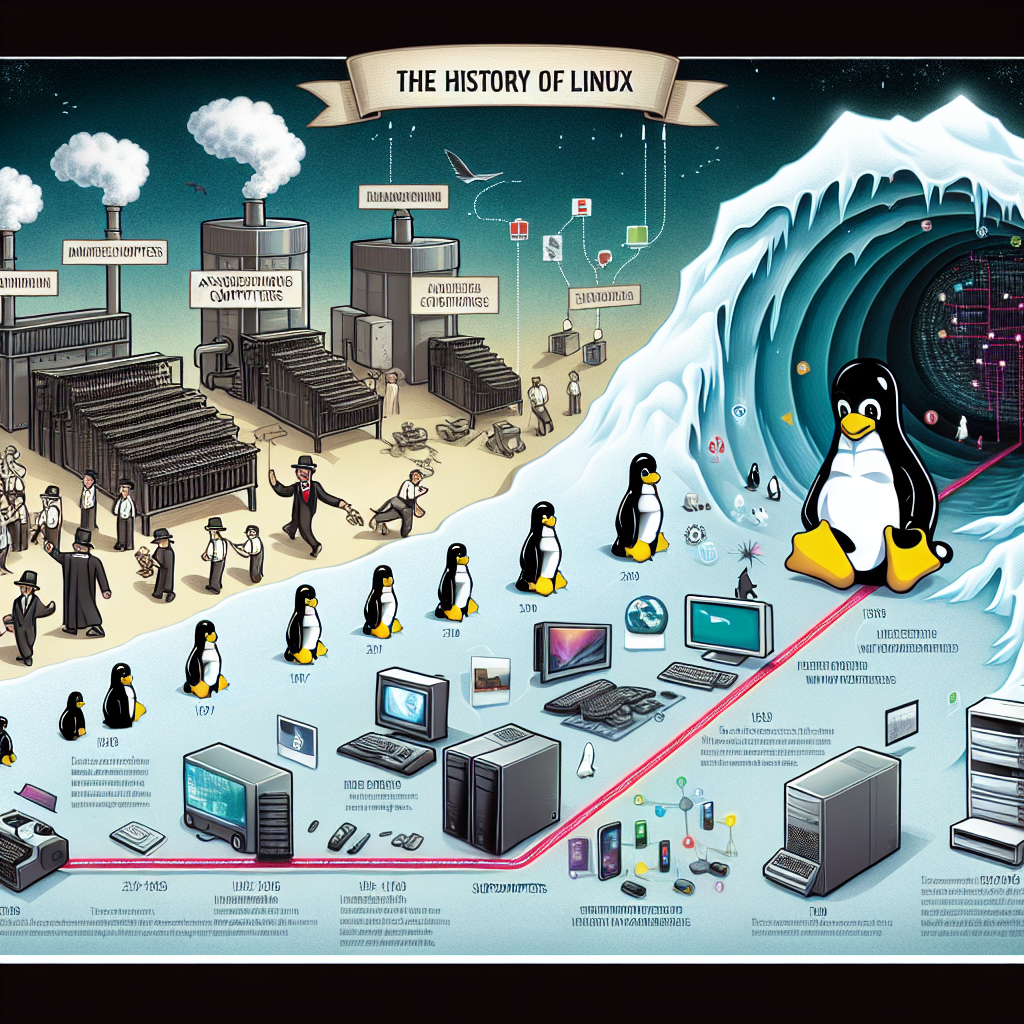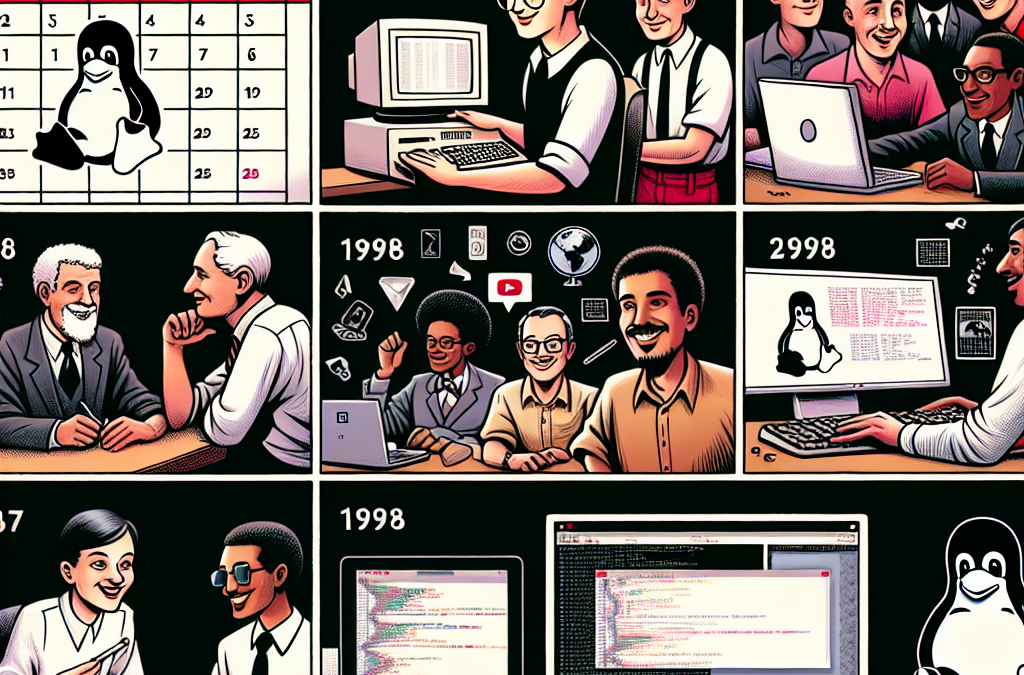The Origins Of Linux: From UNIX To Torvalds
The story of Linux, a free and open-source operating system, is a fascinating journey that begins not with its actual creation but within the corridors of earlier computing innovation. It’s a tale that underscores the power of collaboration, community, and the enduring human spirit to innovate and democratize technology.
Our story starts with UNIX, an operating system developed in the late 1960s by AT&T’s Bell Labs. UNIX was unique for its time, offering powerful multitasking and multi-user capabilities which were revolutionary. However, UNIX was not free, and its proprietary nature meant that it was expensive and inaccessible to many who wished to explore its potential further.
In the 1980s, the desire for a freely accessible system similar to UNIX led to the development of GNU by Richard Stallman. GNU aimed to create a completely free and open UNIX-like operating system. However, by the early 1990s, GNU was still missing a crucial piece: the kernel, which is the core component of an operating system that manages the hardware and software interactions.
Enter Linus Torvalds, a computer science student from Finland, who in 1991 began working on his own kernel, which he famously named Linux. Linus’s initial intention wasn’t to create a full operating system; he simply wanted to explore the capabilities of his new PC’s hardware. However, what started as a personal project quickly escalated into something much larger. After posting about his project on a Usenet newsgroup, Linus found that other developers around the world were interested in his work. They began contributing code, fixing bugs, and suggesting improvements.
The collaborative nature of Linux’s development was both novel and effective. Linus’s decision to make Linux open source meant that anyone could modify the code, improve upon it, and redistribute it, provided they kept it open source. This principle was encapsulated in the GNU General Public License (GPL), which Linux adopted. The GPL ensured that Linux would remain free and open, a stark contrast to the proprietary UNIX.
As more and more developers contributed to Linux, it grew from a modest kernel into a full-fledged operating system. Today, Linux is at the heart of many technology systems, powering everything from the world’s top supercomputers and corporate servers to popular Android smartphones and even household appliances. Its impact is profound, stretching across industries and continents, influencing not only technology but also the culture around it.
The journey from UNIX to Linux is not just about technological evolution but also about a community that believed in the power of open, accessible, and collaborative development. Linus Torvalds’ initial curiosity and subsequent openness to collaboration spawned a global movement that continues to thrive. It’s a testament to how a small personal project can transform into a global phenomenon, all thanks to the spirit of community and shared knowledge.
In essence, the history of Linux is not merely about a shift from proprietary systems to open-source. It’s a story of how openness and collaboration can lead to greater innovation and accessibility in technology. It’s a cheerful reminder that in the world of technology, as in life, we are better together.
Key Milestones In Linux Development

The history of Linux is a fascinating journey through time, marked by innovation, community, and the spirit of open-source collaboration. It all began in 1991, when a young Finnish student named Linus Torvalds embarked on a personal project that would eventually change the world of computing. Initially, Linus set out to create a free operating system kernel that anyone could use and modify. Little did he know, his project would grow into what we now know as Linux, a cornerstone of modern technology.
One of the first key milestones in the development of Linux was its release to the internet. In August 1991, Linus posted a message on a newsgroup for Minix users, inviting them to try out the kernel he had developed. This humble invitation was the spark that ignited a global movement. Enthusiasts from around the world began contributing to the project, each adding their own piece to the puzzle. This collective effort was crucial, as it helped improve the system’s functionality and reliability at an astonishing pace.
As Linux continued to evolve, another significant milestone was the creation of distributions. These are essentially packages that include the Linux kernel along with a variety of software applications, making it easier for users to install and use Linux on their computers. In 1992, the first distributions began to appear. Slackware, created by Patrick Volkerding, and Debian, developed by Ian Murdock, were among the pioneers. These distributions were vital because they made Linux accessible to a broader audience, who might not have the technical skills to compile a kernel but were eager to explore the possibilities of open-source software.
The adoption of Linux by enterprises marked yet another crucial milestone. In the late 1990s and early 2000s, companies began to recognize the value of Linux, particularly for running servers and other critical infrastructure. The stability, cost-effectiveness, and flexibility of Linux made it an attractive option for businesses, leading to its widespread adoption in the corporate world. This shift was significant not only for the growth of Linux but also for the open-source movement as a whole, as it demonstrated that free software could meet or even exceed the performance of proprietary systems.
Perhaps one of the most heartwarming aspects of Linux’s history is its impact on education and developing countries. Because Linux is free and open-source, it has become a valuable tool for educational institutions with limited budgets. Students around the world can learn about computer science and programming without the need for expensive software licenses. Moreover, Linux has empowered developing countries to build and maintain their own IT systems without relying on costly proprietary solutions.
Today, Linux is everywhere—from smartphones and personal computers to supercomputers and space stations. It’s incredible to think that what started as a small project in Linus Torvalds’ dorm room has grown into a global infrastructure. Each milestone in its development has been a stepping stone not just for Linux itself, but for the broader tech community, fostering an environment where anyone, anywhere, can contribute to building something truly amazing.
So, as we look back on the key milestones in the development of Linux, it’s clear that this isn’t just a story about software. It’s a story about people coming together to create something they believe in. It’s a testament to the power of collaboration and the endless possibilities that open-source offers. And that, if you ask me, is something truly worth celebrating.
Influential Linux Distributions Through The Years
Linux, the beloved powerhouse of operating systems, has a rich tapestry of distributions that have shaped its history and influenced the tech world significantly. Each distribution, or ‘distro’ as they are affectionately known, offers a unique flavor of the core Linux kernel, tailored to meet specific needs or philosophies. This personal journey through the influential Linux distributions will not only highlight their contributions but also celebrate the vibrant community behind them.
Our story begins with Slackware, one of the earliest distributions, launched in 1993. Created by Patrick Volkerding, Slackware is renowned for its simplicity and minimalism, which in turn provided a stable and reliable platform for users who preferred a hands-on approach. It’s often praised for its robustness and extensive documentation, making it a favorite among those who wanted to learn the nuts and bolts of Linux.
Transitioning from the foundational impact of Slackware, Debian came onto the scene in 1993 as well. Founded by Ian Murdock, Debian is famed for its strict adherence to the open-source philosophy and its modular design. This distro became the bedrock for many other distributions, including the popular Ubuntu. Debian’s package management system, APT, and the Debian Free Software Guidelines helped shape a well-organized community and a highly versatile operating system platform.
Speaking of Ubuntu, introduced in 2004 by Mark Shuttleworth and his company Canonical, it took the Linux world by storm. Ubuntu’s philosophy of ease-of-use and accessibility brought Linux to a broader audience. With its regular release cycle, comprehensive hardware support, and focus on user experience, Ubuntu has arguably done more to popularize Linux than any other distribution. It’s a cheerful gateway for many newcomers to the world of Linux, providing a polished, ready-to-use environment that contrasts sharply with the more manually intensive distros like Slackware.
Another noteworthy mention is Fedora, launched in 2003 and sponsored by Red Hat. Fedora serves as a testing ground for new technologies, which are later incorporated into Red Hat Enterprise Linux. The distro is known for its innovation and cutting-edge features, making it ideal for those who want to experience the future of Linux technologies. Fedora’s commitment to free software and its proactive community continue to push the envelope, driving the evolution of Linux at a brisk pace.
Lastly, let’s not forget about openSUSE, which started its journey as SUSE Linux in 1994. Known for its YaST configuration tool, openSUSE is a distro that strikes a balance between stability and cutting-edge features. It’s particularly noted for its exceptional tools that simplify system administration and software management, making it a favorite among both newbies and seasoned professionals.
As we reflect on these influential Linux distributions, it’s clear that each has contributed uniquely to the landscape of open-source software. They have not only provided tools and technologies but have also fostered communities that embody collaboration and innovation. The beauty of Linux lies in its diversity, and these distributions exemplify how different philosophies can coexist within a single ecosystem, each playing a vital role in the development and spread of Linux.
In conclusion, the journey through the history of influential Linux distributions is a testament to the power of community-driven technology. Each distro, with its distinct focus and community, has woven a colorful thread into the fabric of the Linux universe, making it as vibrant and dynamic as it is today. Whether you’re a developer, a system administrator, or just a curious onlooker, the world of Linux distributions offers a fascinating glimpse into the possibilities of open-source software.
Discover more from Rune Slettebakken
Subscribe to get the latest posts sent to your email.


